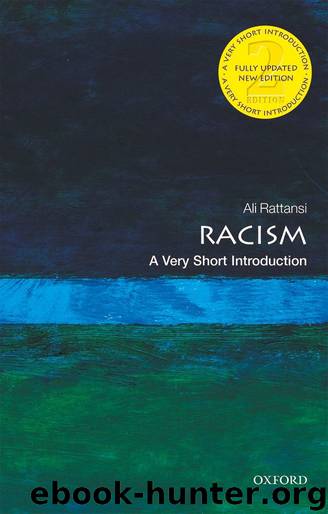Racism by Ali Rattansi

Author:Ali Rattansi [Rattansi, Ali]
Language: eng
Format: epub
ISBN: 9780192571816
Publisher: OUP Oxford
Published: 2019-12-20T00:00:00+00:00
Chapter 5
Structural racism and colourblind whiteness
Structural and systemic racism
From a sociological perspective, current racialized inequalities in white-dominated societies in North America and Europe need to be explored in systemic, structural terms. That is, while individual ‘prejudice’ against populations regarded as non-white, or ‘ethnic minorities’ including white ethnic minorities, is obviously significant—social structures, after all, always involve actors, actions, motives, and conscious and unconscious practices—to understand how racialized inequalities persist over time it becomes necessary to understand how there exist networks of social relations and institutions which have the effect of sustaining a combination of actions, cultures, and practices which then reproduce racialized inequalities over time.
It is important to acknowledge that these structures of racialized inequalities are not unchanging. Individuals from previously subordinate racialized minorities can and do move up the socio-economic hierarchy, such that black people in the USA, for example, now have a substantial middle class composed of businesspeople, lawyers, doctors, school teachers, and academics teaching and researching at university level. It is also the case that both in the USA and the UK, for example, over time fewer and fewer individuals will explicitly identify as ‘racist’ or ‘racially prejudiced’. For a lengthy period since the arrival of so-called ‘coloured immigrants’ into the UK after the end of World War II, the numbers of those claiming to be racially prejudiced have been falling. For example, unlike the very racially hostile period that characterized public life during the 1950s and 1960s, research in 2017 by the British National Centre for Research, in collaboration with the Runnymede Trust, found that 26 per cent of people described themselves as ‘very’ or a ‘little’ prejudiced towards people of other ‘races’.
However, this figure has risen from when a similar survey was undertaken in 2001. It has been argued that growing hostility may be explained by rising intolerance towards Muslims since the attacks of 9/11. Note, though, that in 1987 38 per cent of people polled said that they were either ‘very or a little prejudiced’ against people of other ‘races’.
Results from this type of survey research need to be interpreted with caution, because respondents have become only too aware that ‘racial prejudice’ is frowned upon, partly as a result of race relations legislation that has outlawed direct and indirect discrimination.
Structural or systemic racism cannot be treated completely separately from what has come to be called ‘institutional racism’. Societies are made up of institutions such as schools, prisons, the courts that administer justice, hospitals, and police forces. Systemic or structural racism is usually applied as a concept to characterize a set of interrelated relationships that include institutions and individuals. Studies of structural and systemic racism therefore focus on how the interrelationships reproduce the subordinate and superior positions occupied by racialized populations. White people, of course, are included as part of racialized groups, for they occupy a dominant position in the USA and the UK, which are societies that are in general racialized. A distinction has to be made between ‘whiteness’ and white people in the context of structural racism, and any discussion of whites has to be recognized as also racialized.
Download
This site does not store any files on its server. We only index and link to content provided by other sites. Please contact the content providers to delete copyright contents if any and email us, we'll remove relevant links or contents immediately.
| General | Discrimination & Racism |
Nudge - Improving Decisions about Health, Wealth, and Happiness by Thaler Sunstein(6629)
iGen by Jean M. Twenge(4693)
The Fire Next Time by James Baldwin(4336)
Adulting by Kelly Williams Brown(3663)
The Sports Rules Book by Human Kinetics(3581)
The Hacking of the American Mind by Robert H. Lustig(3575)
The Ethical Slut by Janet W. Hardy(3494)
Captivate by Vanessa Van Edwards(3292)
Mummy Knew by Lisa James(3164)
In a Sunburned Country by Bill Bryson(2941)
Ants Among Elephants by Sujatha Gidla(2920)
The Worm at the Core by Sheldon Solomon(2910)
Suicide: A Study in Sociology by Emile Durkheim(2606)
The Slow Fix: Solve Problems, Work Smarter, and Live Better In a World Addicted to Speed by Carl Honore(2570)
Humans of New York by Brandon Stanton(2376)
Handbook of Forensic Sociology and Psychology by Stephen J. Morewitz & Mark L. Goldstein(2376)
Blackwell Companion to Sociology, The by Judith R. Blau(2314)
The Happy Hooker by Xaviera Hollander(2272)
Outliers by Malcolm Gladwell(2254)
